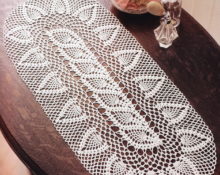 Many years ago, crocheted items were present on almost every square meter in the house. And now on every street corner you can see a shop with a bunch of handicraft goods. This means only one thing - the craft has returned. It has become fashionable to do handicrafts. Girls are happy to learn new techniques and share secrets with their friends. Knitted products for the home are especially valued. These are different decorative items and especially tablecloths. What lovely table covers you can make with crochet. What you need for this is patience, yarn and a hook. Below are a few mind-blowing patterns for knitting a beautiful tablecloth. And for those who have little understanding of crochet patterns, detailed master classes on how to make a simple model and a more complex product at home.
Many years ago, crocheted items were present on almost every square meter in the house. And now on every street corner you can see a shop with a bunch of handicraft goods. This means only one thing - the craft has returned. It has become fashionable to do handicrafts. Girls are happy to learn new techniques and share secrets with their friends. Knitted products for the home are especially valued. These are different decorative items and especially tablecloths. What lovely table covers you can make with crochet. What you need for this is patience, yarn and a hook. Below are a few mind-blowing patterns for knitting a beautiful tablecloth. And for those who have little understanding of crochet patterns, detailed master classes on how to make a simple model and a more complex product at home.
What threads are suitable for crocheting a tablecloth?
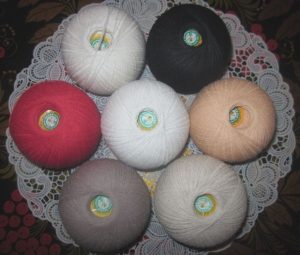 The tablecloth can be made from almost any yarn. But craftsmen often recommend finer fibers, such as cotton or iris. With them you can create not only thick fabrics, but also lace options. And lace looks better in a thin thread and a solid color.
The tablecloth can be made from almost any yarn. But craftsmen often recommend finer fibers, such as cotton or iris. With them you can create not only thick fabrics, but also lace options. And lace looks better in a thin thread and a solid color.
How to calculate the size of a tablecloth for a rectangular table
A very interesting question regarding the size of the tablecloth. They are all different, and each has its own allowance. In fact, calculating the size is very simple; you just need to measure the length and width of this table, and then add an allowance to each measurement, which is multiplied by 2. Following the rule of good manners, further details about the allowance itself.
 Allowance for everyday wear. For every day tablecloth or just a home option - this is not too drooping. For it, the allowance is used in the range of 15–20 cm. This length is convenient to use.
Allowance for everyday wear. For every day tablecloth or just a home option - this is not too drooping. For it, the allowance is used in the range of 15–20 cm. This length is convenient to use.- For the holidays. This model is designed for a holiday at home. Here it’s worth covering the table legs a little more than for everyday use. The allowance for this option will be in the range of 20–30 cm.
- Wedding, official reception and banquet. A significant event and for such events the model should hang 40 cm from the edge.
- Buffet serving. In the case of a buffet table, the table legs should not be visible at all, and therefore the tablecloth should be level with the floor. Therefore, you should also measure the height of the table.
Following the rules of good manners, you can knit several tablecloths for different occasions. And use them as the celebration approaches.
Important! Based on the required allowance, you need to cast on the correct number of loops and knit as many repeats in height as the dimensions require. This must be done according to the density of the knitting.
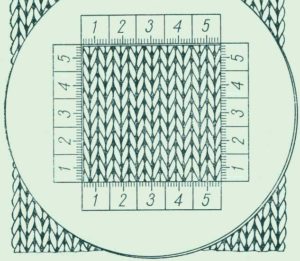 A sample will help determine the tightness of the knitting. These are several reports (a small square or a small motif), where everything is created based on the model’s pattern.Then substitute a ruler and count how many (columns and other elements) 10 cm fits horizontally and vertically. Two numbers will make up the knitting density. Simple mathematics will help you convert all measurements into loops. Let's create an equation with an unknown variable and solve it by proportion.
A sample will help determine the tightness of the knitting. These are several reports (a small square or a small motif), where everything is created based on the model’s pattern.Then substitute a ruler and count how many (columns and other elements) 10 cm fits horizontally and vertically. Two numbers will make up the knitting density. Simple mathematics will help you convert all measurements into loops. Let's create an equation with an unknown variable and solve it by proportion.
x – number of loops in the set;
a - cm for set;
c - loops 10 cm;
s - 10 cm.
x = (ab)/s.
Selection of patterns for crochet tablecloths on a rectangular table
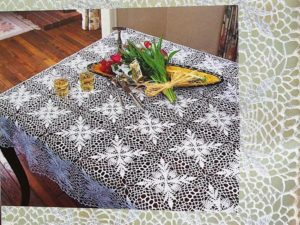 Finding patterns for tablecloths is also time-consuming. Now you don’t have to waste it, because below are the coolest patterns from the search for creating a rectangular tablecloth. It’s also convenient that they are all divided into categories for beginners and slightly more complex models. And a new branch is a category for making a decorative element for a tablecloth. A simple canvas would be boring without a little embellishment to add to one of the dangling edges.
Finding patterns for tablecloths is also time-consuming. Now you don’t have to waste it, because below are the coolest patterns from the search for creating a rectangular tablecloth. It’s also convenient that they are all divided into categories for beginners and slightly more complex models. And a new branch is a category for making a decorative element for a tablecloth. A simple canvas would be boring without a little embellishment to add to one of the dangling edges.
Schemes for beginners
A very simple pattern of double crochets, chain stitches and single crochets. The result is a canvas with small flowers and something very reminiscent of a net.

Next are three patterns from the fillet mesh category with very beautiful patterns of flowers and leaves.

A simple diagram with petals.
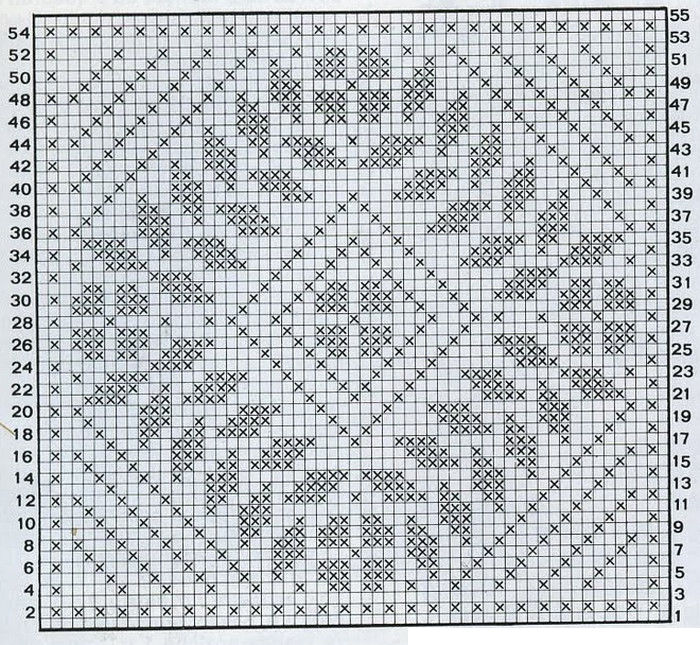
Another simple version of fillet knitting.

The last model is more complex, with a border and different elements for it. These patterns are suitable for a beginner, as the patterns are not very complex and do not require constant counting of stitches. Behind the mesh comes a flower, followed by a simple mesh again.
Interesting patterns for crocheting a tablecloth
Very beautiful models can be made according to the diagrams below.
An interesting scheme with rectangular motifs.

Quite a thick tablecloth made of double crochets.

Openwork tablecloth with cones.

Pattern for knitting items with a large hem.

Scheme with a flower of 4 petals.

Thick tablecloth with interesting patterns.

These patterns require crocheting skills. But if a beginner believes in his abilities, then why not try his hand at making rather unusual models for the table.
Knitting patterns for decorative elements for tablecloths
It's not just the border that helps complement the tablecloth. A little decor will help make it less boring. let it be a tiny heart and the tablecloth will no longer be the same as everyone else’s.

And what charming flowers can be made using the given patterns. Very nice. Shouldn't the resulting tablecloth be cute and warm?

Variant of knitting daisies.

Volumetric rose made of threads.

How to knit a simple tablecloth on a rectangular table step by step
A very beautiful and very simple tablecloth with birds for a rectangular table. The model was made using a simple fillet mesh with a simple fabric pattern.

To work you will need:
- iris yarn approximately 200 g;
- hook number 0.85.
The size of the product will be 100 x 60 cm.

Stage: set. Crochet 366 chain stitches.
1st row: knit 1 dc in the 9th loop and so you get the first square, * 2 chain loops, double crochet in the 3rd and continue such squares until the end of the row. The work is done using the fillet knitting technique. Knit the completed squares of the pattern using double crochets.
Stage: border. Only 4 rows were used for tying and they are presented in the diagram.

Stage: drying. To get a flat and very even product, you need to wet a towel and spread the finished work, place the towel on top and wait until it dries completely. Then iron with an iron.
Crochet a festive tablecloth: step-by-step description
Very elegant model made of fine lace.In fact, it is not as difficult to do as it might seem in the finished version. The entire canvas consists of small motifs. These are squares with a side of about 10 cm. Charming snowflake squares make up the entire product.

To work you will need:
- fine yarn (cotton or iris);
- hook according to the thickness of the thread.

Stage: measurements. We took measurements for our table according to the proposed option.
Stage: sample. In this case, one motive must be used as a sample. Measure its sides and calculate how many such motifs will be needed based on the dimensions of the length and width of the required product.
Stage: motive. Execute the motive according to the proposed scheme. A charming square starts from the center. This is a ring of air loops. Further in a circle there are 10 rows and the motif is ready. Due to the special addition on 4 sides in each row, a square product is obtained.

Motif diagram:
- 1st row: after the ring of chain stitches (16), a row of double crochet stitches begins, knit 31 double crochet stitches (use 3 chain stitches for lifting), at the end make a simple connecting stitch.
- 2nd row: three lifting air loops, 3 in. n., two double crochet stitches in the following stitches, two in. p., 4 double crochets, 2 in. p. and then the report begins again (there should be 4 reports in the circle).
- 3rd row: consists of 4 reports (2 double crochets, 3 ch, 2 double crochets, 2 ch, 8 double crochets, 2 ch).
- 4th row: consists of 4 reports (2 double crochets, three ch, two double crochets, 2 ch, 12 double crochets, 2 ch).
- 5th row: consists of 4 reports (2 double crochets, 3 ch, 2 double crochets, three ch, 16 double crochets, 3 ch).Next, do the same with adding loops.
Stage: assembly. Knit the required number of motifs and then simply sew them at the corners.
This is how you get a very beautiful and festive model.


 Allowance for everyday wear. For every day tablecloth or just a home option - this is not too drooping. For it, the allowance is used in the range of 15–20 cm. This length is convenient to use.
Allowance for everyday wear. For every day tablecloth or just a home option - this is not too drooping. For it, the allowance is used in the range of 15–20 cm. This length is convenient to use. 0
0



